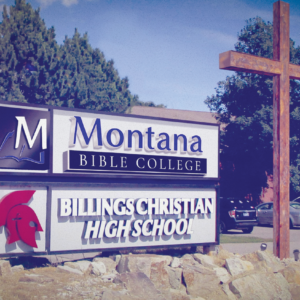Nicholas Lynn is the current owner of Montana Action Paintball in Kalispell. Lynn built a new facility in 2020. Montana Action Paintball hopes to find an indoor space for foam-based weaponry battles or paintball using rubber paintballsduring bad weather.
The Fish Consumption Advisory Board has issued a consumption advisory on all fish species in the Yellowstone River from Indian Fort Fishing Access Site near Reed Point to the Highway 212 bridge in Laurel. That stretch of the river is near the site of the June 24 train derailment.
Stack Financial Management of Whitefish was ranked No. 72 in the 2023 CNBC Financial Advisor 100. In assembling this list, CNBC considers the firm’s number of years in business, compliance record, number of investment advisors registered, and assets under management. Stack Financial Management manages over $1.8 billion in assets for individuals and businesses across the U.S.
Blackfoot Communications, Missoula, announced the completion of a project to install over 380 miles of fiber optic cable on the Flathead Reservation in the St. Ignatius area. The project, begun in 2018, cost over $11 million. Nearly 1,000 locations throughout the St. Ignatius area are now served by high-speed fiber optic cable. The company is also building out fiber networks in Thompson Falls, Plains, Philipsburg and Georgetown Lake, with other areas in the planning phases.
The New York Times published its annual list of its 50 most intriguing restaurants. Campione, located on Main Street in Livingston was on the list. Campione’s was the only eating establishment in Montana to make the list.
As a part of continued efforts to lower costs to reliable air service for rural communities, the U.S. government has secured $1,000,000 in funding for Billings to attract new air carriers and secure additional routes to the west coast. As a senior member of the Senate Appropriations Committee, Senator Tester secured funds through the 2023 government funding bill. He was the only member of the Montana delegation to support the legislation.
Montana manufacturing will be in the spotlight until Oct. 24. Manufacturers, economic development organizations and educational partners will showcase industry innovations and inspire the next generation at events coordinated by Montana State University and collaborators. Manufacturing Day, also known this year as MFG Day, is a national event held annually to inspire the next generation of workers and industry leaders, improve people’s perception of manufacturing and build the workforce of the future.
At the recent annual convention of the North Dakota Dental Association a Williston-based dentist named Dr. Kami Dornfeld was announced as the association’s president for the next year.
Along with their son and daughter, the Horning family of Whitefish dedicates their craftsmanship to niche profession, custom hat making. Glacier Rim Hats is based out of the family’s home. From crepes to photography, the Horning’s have been in business since 2005.
Stylist Kae Briggs has opened a new salon in Choteau. “K’s Salon and Boutique” will offer services for hair and nails. The staff includes Briggs and Peggy Archer, who is a long-time stylist and the former owner of Archer’s Country Classics Hair Design.
Alpha Loading Systems in Stevensville celebrated an expansion of its plant that will triple its work force.. The company, created by Bitterroot Tool & Machine in 1999, is a manufacturer of ammunition loading and priming machinery. The company expanded to accommodate increased demand for their American-made machinery and ammunition.
The U.S. Environmental Protection Agency (EPA) has deleted the Anaconda Co. Smelter site from Superfund’s National Priorities List. NPL site deletion helps communities move forward in reusing and redeveloping properties by making it clear that cleanup is complete.
The Finally Restaurant Group, announced the opening of its newest Rib & Chop House restaurant in Great Falls, which will hire upward of 100 people in the coming weeks. Burke Moran, is the owner and President of Finally Restaurant Group.
Chick-fil-A will debut on the campus of Montana State University. Currently, the Union Market in the Strand Union Building is under construction as they prepare to open the new franchise in spring 2024. According to the Culinary Services department, Chick-fil-A is still pursuing a new full location at 19th Avenue and I-90.
Florence Crittenton Family Services in Helena has reopened its Youth Maternity Home having had to close during COVID restrictions and employee shortages.
In Park County a 3,360 square foot building in which to accommodate the Windrider Transit Facility has opened. The building includes two office spaces, an entry area, a driver /training kitchenette area, janitor rooms and a ADA compliant bathroom. Five years ago, Park County started Windrider to provide fare-free fixed route services for county residents, including the elderly, disabled and youth who had no other means of transportation.
Gallatin Association of Realtors newly elected Director and Officers are:2024 President-Elect, Hattie Graham, Graham Realty; GAR Vice President, Mark Corner, Coldwell Banker Distinctive Properties; 2024-2026 GAR Board of Directors: Tyler Garrison, ERA Landmark Real Estate, Jody Savage, Savage Real Estate Group, Kathleen Vaughn, Bozeman Real Estate Group.
An analysis found that 14.1% of workers in the Billings metro area are union members, compared to 10.1% of workers nationally. In 2022, the median wage for full-time union workers was $1,216 per week, compared to only $1,029 per week for full-time non-union workers.
The annual facelift of MSU’s “Rockin’ the M,” on the Bridger Mountain, took place as usual on Sept. 17, but more work is being done to shore up the landmark. Timbers needed to construct a retaining wall at the base of the “M” will be airlifted to the worksite by helicopter.
The Montana Highway Patrol commissioned nine new troopers at a graduation ceremony held Sept. 29 at the Civic Center in Helena. They came from as far away as California, Texas and Virginia. Three of them are from Montana..


